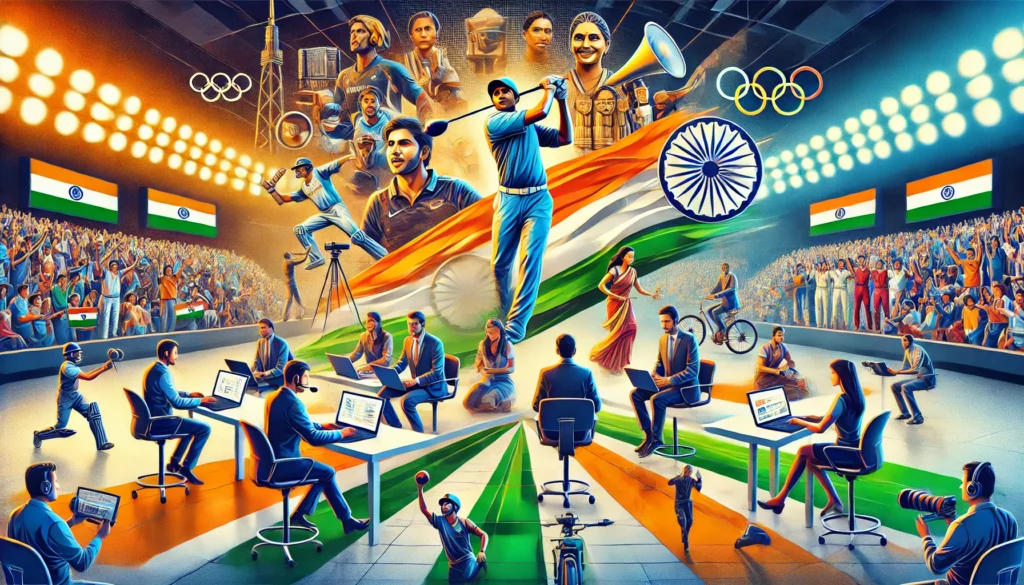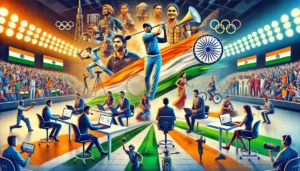
Sports journalism plays a pivotal role in shaping the way sports are perceived and discussed in India, influencing not only fans but also the general public’s understanding of sports culture. Through the stories they tell, sports journalists bring attention to the achievements, struggles, and behind-the-scenes aspects of sports that often go unnoticed. This narrative-building process helps create heroes out of athletes, generate excitement for sporting events, and even shape the national identity through sports. The impact of sports journalism extends beyond just reporting scores and highlights; it involves analyzing the social, economic, and cultural significance of sports, thus contributing to the larger discourse around sports in India. As the country continues to evolve as a sports-loving nation, the role of journalism in guiding public perception and enthusiasm for various sports cannot be overstated. With the advent of digital media, the reach of sports journalism has expanded further, allowing stories of triumph and struggle to reach every corner of the nation, fostering a deeper connection between sports and society.
Evolution of Sports Journalism in India
The landscape of sports journalism in India has undergone significant transformations over the decades, evolving alongside the changes in media consumption and technology. This evolution has seen a shift from traditional print media to digital platforms, reflecting the changing ways in which audiences consume sports content.
From Print Media to Digital Platforms
In its early days, sports journalism in India was dominated by print media. Newspapers like The Times of India, The Hindu, and The Indian Express were key players in delivering sports news to the public. Coverage primarily focused on cricket, India’s most beloved sport, but other sports like hockey, athletics, and football also received attention during national events. The narratives constructed through these print outlets shaped the public’s perception of sports, creating lasting memories and legends of the game. However, with the rise of digital platforms, the way sports stories are told and consumed has dramatically changed. Online news websites and sports blogs now provide real-time updates, in-depth analysis, and a broader range of perspectives, reaching audiences that print media could not.
The Impact of Television Broadcasts on Sports Coverage
The introduction of television broadcasts in India, especially through networks like Doordarshan in the 1980s, brought a new dimension to sports journalism. Live coverage of cricket matches and Olympic events allowed fans to witness the action as it unfolded, creating a more immediate and engaging experience. This era saw the rise of cricket commentators who became household names, bringing the game into living rooms across the nation. The growth of private sports networks like Star Sports and Sony further revolutionized sports journalism, offering dedicated channels and programs that analyzed matches, interviewed players, and provided expert opinions. This shift from print to visual storytelling significantly impacted the way sports were perceived, making stars out of athletes and fostering a stronger emotional connection between fans and their favorite teams.
Rise of Social Media and Citizen Journalism
With the advent of social media, sports journalism in India entered a new phase where fans became active participants in the conversation. Platforms like Twitter, Instagram, and YouTube have allowed fans to share their views, create content, and even break sports news through fan channels and independent blogs. This rise of citizen journalism has democratized sports coverage, allowing stories of lesser-known sports and athletes to reach a wider audience. Social media has also become a critical tool for journalists to engage with fans, share real-time updates, and provide behind-the-scenes insights that traditional media cannot. While this has expanded the reach of sports journalism, it has also introduced challenges in ensuring the credibility and accuracy of information shared online.
The evolution of sports journalism in India is a testament to the dynamic nature of the media landscape, adapting to new technologies and audience preferences. As the industry continues to grow, it is set to play an even more significant role in shaping the narratives around sports in the country.
Key Responsibilities of Sports Journalists
Sports journalists in India have a critical role in shaping how the public understands and appreciates sports. Their responsibilities go beyond mere reporting of scores; they are tasked with providing context, offering insights, and ensuring that a balanced and accurate portrayal of sports events reaches the audience. Their work helps to inform, inspire, and educate sports enthusiasts and casual readers alike.
- Providing Accurate and Unbiased Reporting
One of the foremost responsibilities of sports journalists is to deliver accurate and unbiased reporting. They must ensure that the information they provide is fact-checked and presented without personal biases, as their reports can significantly influence public opinion and perceptions about players, teams, and the outcomes of events. Objectivity is especially important in a country like India, where sports often evoke strong emotions. - Highlighting Underrepresented Sports and Athletes
In a cricket-dominated country, it is crucial for sports journalists to shine a light on other sports and the athletes who excel in them. Coverage of sports like kabaddi, hockey, wrestling, and badminton helps bring these disciplines to the forefront, providing a platform for athletes who might otherwise go unnoticed. By telling their stories, journalists contribute to diversifying the sports narrative in India. - Educating the Public on Sports Policies and Events
Sports journalism also plays an educational role, helping the public understand the rules, policies, and significance of various sporting events. This can include explaining the nuances of international tournaments, the selection processes for national teams, or the implications of new sports policies. By breaking down complex information into understandable narratives, journalists help create a more informed audience.
By fulfilling these responsibilities, sports journalists play a vital role in creating a well-rounded and inclusive sports culture in India, one that celebrates the spirit of competition and the hard work of athletes across all disciplines.
Top 5 Influential Sports Journalists in India
Sports journalism in India has been shaped by several influential figures who have brought sports stories to life through their unique insights and engaging storytelling. Here are five sports journalists who have made a significant impact on India’s sports narrative:
- Harsha Bhogle
Known as the “Voice of Cricket,” Harsha Bhogle has been a prominent commentator and sports journalist for over three decades. His insightful analysis and engaging commentary have made him a beloved figure among cricket fans, bringing a deep understanding of the game to millions of viewers. - Sharda Ugra
Sharda Ugra has been a trailblazer in sports journalism, focusing on both mainstream and underrepresented sports. Her work has highlighted the challenges faced by athletes in India, particularly those in lesser-known sports, and she is known for her fearless and well-researched reporting. - Boria Majumdar
As a leading sports historian and journalist, Boria Majumdar has made significant contributions to the understanding of India’s sports history. His books and articles provide deep insights into the cultural impact of sports in India, and he has covered a wide range of sports beyond cricket, including the Olympics. - Ayaz Memon
Ayaz Memon, popularly known as “Cricketwallah,” has been a respected voice in Indian sports journalism for decades. His expertise in cricket and in-depth analysis of the sport have made him a go-to figure for cricket enthusiasts, and he has been a mentor to many aspiring sports journalists. - Nikhil Naz
Nikhil Naz is known for his dynamic presence on television and social media, covering cricket and other sports. His interviews with players and analysis of matches bring a fresh perspective, making sports coverage more accessible and engaging for younger audiences.
These journalists have each contributed to shaping the sports landscape in India, using their platforms to tell compelling stories and provide critical analysis that informs and entertains their audiences.
Challenges Faced by Sports Journalism in India
Sports journalism in India, while crucial in shaping the sports narrative, faces several challenges that can impact the quality and breadth of coverage. These challenges range from maintaining journalistic integrity to balancing coverage between popular and less mainstream sports.
Balancing Sensationalism and Authenticity
One of the major challenges in sports journalism is striking a balance between creating engaging content and maintaining authenticity. In the race to attract viewers and clicks, there can be a temptation to focus on sensational stories, rumors, or controversies, which may overshadow the true essence of sports. This shift can sometimes compromise the depth and accuracy of reporting, leading to a misrepresentation of athletes and their achievements. Journalists must navigate this delicate balance, ensuring that their storytelling remains true to the sport while also engaging their audience.
Limited Coverage of Non-Cricket Sports
In India, cricket dominates the media landscape, often at the expense of other sports. While cricket’s popularity is undeniable, this focus can leave other sports like hockey, football, badminton, and athletics struggling for media attention. This limited coverage makes it difficult for these sports to gain traction among the general public, affecting sponsorship opportunities and overall growth. Sports journalists play a crucial role in addressing this imbalance by highlighting achievements in non-cricket sports and bringing attention to the stories of athletes from various disciplines.
Press Freedom and Censorship Issues
Like many sectors in Indian media, sports journalism can face challenges related to press freedom and censorship. Journalists reporting on sports administration, corruption, or governance issues may find themselves under pressure to avoid certain topics. This can limit the transparency of sports coverage and prevent important stories from reaching the public. Ensuring that sports journalism remains free to report on all aspects of the sports industry is essential for maintaining public trust and accountability.
Addressing these challenges is vital for the growth and credibility of sports journalism in India. By focusing on accurate, diverse, and fearless reporting, sports journalists can continue to shape a more balanced and inspiring sports narrative.
Building a Stronger Sports Narrative for India through Journalism
Creating a stronger sports narrative for India requires a concerted effort from sports journalists to focus on stories that inspire, educate, and unite the nation. It is not just about celebrating victories, but also about highlighting the struggles and journeys of athletes, the evolution of different sports, and the impact of sports on social change. By bringing attention to underrepresented sports and regional competitions, journalists can ensure that the narrative is inclusive and reflective of India’s diverse sports culture.
Collaborating with schools, universities, and local sports clubs can help journalists uncover stories of grassroots development, where the next generation of athletes is nurtured. These stories can build a sense of pride and belonging among readers and viewers, fostering a deeper connection with sports beyond just mainstream events. Additionally, engaging with sports fans through digital platforms allows journalists to create a more interactive narrative, where the audience can share their perspectives and become a part of the conversation.
A strong sports narrative also means holding sports bodies accountable and providing critical analysis of policies that affect the sports ecosystem in India. Through investigative journalism and thought-provoking commentary, journalists can play a role in driving reforms and improvements in the way sports are managed and promoted in the country. This comprehensive approach to sports journalism will ensure that India’s sports narrative is one that celebrates progress, acknowledges challenges, and strives for excellence.






